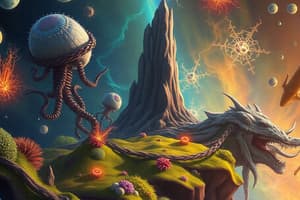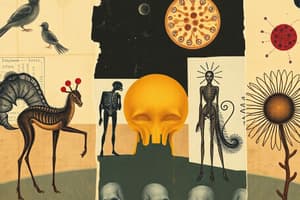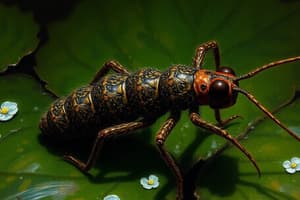Podcast
Questions and Answers
Which group of organisms is exclusively unicellular?
Which group of organisms is exclusively unicellular?
- Animals
- Bacteria (correct)
- Plants
- Fungi
Which kingdom includes organisms that are primarily heterotrophic?
Which kingdom includes organisms that are primarily heterotrophic?
- Protists (correct)
- Viruses
- Bacteria (correct)
- Plants
What distinguishes eukaryotic cells from prokaryotic cells?
What distinguishes eukaryotic cells from prokaryotic cells?
- Size difference
- Ability to photosynthesize
- Absence of a nucleus
- Presence of mitochondria (correct)
What is a primary characteristic of fungi?
What is a primary characteristic of fungi?
Which of the following statements is true about viruses?
Which of the following statements is true about viruses?
Which of the following organisms are known to be pathogens?
Which of the following organisms are known to be pathogens?
What type of nutrition do most protists utilize?
What type of nutrition do most protists utilize?
Which of the following statements about autotrophs is correct?
Which of the following statements about autotrophs is correct?
What is a major consequence of habitat loss for animal populations?
What is a major consequence of habitat loss for animal populations?
Which strategy is NOT essential for long-term conservation efforts?
Which strategy is NOT essential for long-term conservation efforts?
How does climate change affect animal species?
How does climate change affect animal species?
What role does pollution play in animal diversity?
What role does pollution play in animal diversity?
Which of the following is an effective way to protect biodiversity?
Which of the following is an effective way to protect biodiversity?
What is the primary role of natural selection in animal diversity?
What is the primary role of natural selection in animal diversity?
Which of the following phyla is characterized by having segmented body structures?
Which of the following phyla is characterized by having segmented body structures?
What is cephalization in the context of animal anatomy?
What is cephalization in the context of animal anatomy?
Which of the following best describes the heterotrophic nature of animals?
Which of the following best describes the heterotrophic nature of animals?
How does geographic isolation contribute to animal diversity?
How does geographic isolation contribute to animal diversity?
Why is animal diversity important for ecosystems?
Why is animal diversity important for ecosystems?
Which of the following is a characteristic example of the phylum Chordata?
Which of the following is a characteristic example of the phylum Chordata?
What impact does cellular differentiation have on animals?
What impact does cellular differentiation have on animals?
Flashcards
What are autotrophs?
What are autotrophs?
Organisms that obtain energy from sunlight through photosynthesis, like plants.
What are heterotrophs?
What are heterotrophs?
Organisms that must consume other organisms for energy, like animals and fungi.
What are protists?
What are protists?
A group of unicellular organisms that can be either autotrophs or heterotrophs, some can be pathogens.
What are animals?
What are animals?
Signup and view all the flashcards
What are plants?
What are plants?
Signup and view all the flashcards
What are fungi?
What are fungi?
Signup and view all the flashcards
What are bacteria?
What are bacteria?
Signup and view all the flashcards
What are viruses?
What are viruses?
Signup and view all the flashcards
Habitat Loss
Habitat Loss
Signup and view all the flashcards
Pollution
Pollution
Signup and view all the flashcards
Overexploitation
Overexploitation
Signup and view all the flashcards
Climate Change
Climate Change
Signup and view all the flashcards
Habitat Protection and Restoration
Habitat Protection and Restoration
Signup and view all the flashcards
Natural Selection
Natural Selection
Signup and view all the flashcards
Speciation
Speciation
Signup and view all the flashcards
Phylum
Phylum
Signup and view all the flashcards
Bilateral Symmetry
Bilateral Symmetry
Signup and view all the flashcards
Cephalization
Cephalization
Signup and view all the flashcards
Heterotrophic
Heterotrophic
Signup and view all the flashcards
Ecosystem Health
Ecosystem Health
Signup and view all the flashcards
Animal Conservation
Animal Conservation
Signup and view all the flashcards
Study Notes
Overview of Life
- Five kingdoms of life exist: animals, plants, fungi, protists, and bacteria.
- Viruses are not living organisms and do not belong to a kingdom.
- Animals, plants, fungi, and protists are eukaryotes.
- Bacteria are prokaryotes.
- Viruses are smaller than prokaryotic cells, which are smaller than eukaryotic cells.
Animals
- Estimated 5-10 million animal species on Earth.
- Multicellular organisms.
- Heterotrophs that obtain energy by consuming other organisms.
- Most reproduce sexually.
- Diverse in body structures, behaviors, and evolutionary histories.
- Classified based on shared characteristics, evolutionary relationships, and ecological roles.
- Includes various phyla like Porifera (sponges), Cnidaria (jellyfish, corals), Platyhelminthes (flatworms), Annelida (segmented worms), Mollusca (mollusks), Arthropoda (insects, crustaceans, arachnids), Echinodermata (sea stars, sea urchins), and Chordata (vertebrates).
- Many show bilateral symmetry (distinct left and right sides) and cephalization (sensory organs concentrated at one end).
- Exhibit various feeding strategies, locomotion methods, and reproductive methods.
- Play crucial roles in ecosystem health and stability: pollination, nutrient cycling, seed dispersal.
- Valuable sources of food, medicinal compounds, and economic resources.
- Faced with threats like habitat loss, pollution, overexploitation, and climate change.
- Conservation efforts are critical for maintaining ecosystem balance and biodiversity.
Plants
- Estimated 300,000 species.
- Multicellular organisms.
- Autotrophs—obtain energy from sunlight via photosynthesis.
Fungi
- Can be multicellular or unicellular.
- Heterotrophs—obtain energy from other organisms.
- Feed through saprotrophic nutrition (secreting enzymes to break down food, then absorbing nutrients).
- Multicellular fungi have a mycelium (body) composed of hyphae (thread-like structures).
- Some fungi are pathogens (e.g., athlete's foot).
Protists
- Mostly unicellular organisms.
- Can be photoautotrophs (have chloroplasts for photosynthesis) or heterotrophs (consume other organisms).
- Most are not harmful, but some are pathogens (e.g., Plasmodium causing malaria).
Bacteria
- Unicellular organisms found in diverse environments.
- Some can photosynthesize, but none have chloroplasts.
- Most feed off other organisms (living or dead).
- Likely more bacterial species than all other kingdoms combined.
- Some are pathogenic (e.g., Salmonella), but many are beneficial (e.g., gut bacteria aiding digestion).
Viruses
- Not considered cells or living organisms.
- Extremely small particles (millions could fit on a fingernail).
- Have a protein coat surrounding genetic material (DNA or RNA).
- Can only reproduce inside living cells (animals, plants, protists, fungi, or bacteria).
- Considered parasites (depend on others for reproduction).
- All viruses are pathogens.
- Examples: influenza virus, tobacco mosaic virus, HIV, COVID-19.
Studying That Suits You
Use AI to generate personalized quizzes and flashcards to suit your learning preferences.




